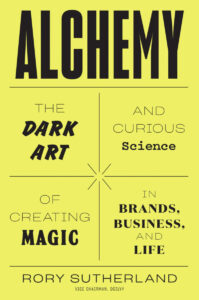Book Summary:
Alchemy by Rory Sutherland
Alchemy by Rory Sutherland

🛍️ Buy this book on Amazon (Audible, Kindle, or paperback): https://amzn.to/3wQUx4u
😋 Thanks! By buying books through my affiliate link, you’re supporting my work (and my hummus addiction).
🗒 Note: My notes are a mix of key ideas and quotes from the book as well as my own thoughts.
💡 The opposite of a good idea can be a very good idea.
- Why the corporate world is not creative – No one was fired for using too much logic. People try to justify their decisions with pure logic so that they won’t be blamed for the results. But, the non-rational solution might actually be better.
- Writing for a persona vs. writing for one person – If you always try to use data to determine who is your average client, you’ll often target people who rarely exist. Don’t design for the average; design for the typical.
- Behavioral psychology in action: Ogilvy London painted baby faces on shop shutters to reduce vandalism.
- Everything can become exclusive. Before Dyson, vacuum cleaners were generic products. Now, they’re a status symbol.
"The heart has reason in which reason knows nothing."
💲 We enjoy buying either very cheap or very expensive stuff.
These both give us a dopamine boost and make for a good story.
- Gifts — People often struggle to find gifts for their loved ones.
Define your product as a gift.
That’s why many online shops add “given as a gift” to product descriptions.
- Pricing tip – show three options with Decoy Pricing:
1. Cheap
2. Premium The one you want the client to take
3. Decoy An offer so bad that choosing the premium option becomes a no-brainer
- On how to acquire gold from iron — During a crisis, Prussia asked rich people to donate their gold jewelry in exchange for iron jewelry. A little engraving on the metal jewelry stated it was given in return for gold.
Suddenly, wearing metal jewelry became a high-status symbol.
- On creating desire — The Prussian king, Friedrich, wanted to turn potatoes into a desirable vegetable because people didn’t want to eat and grow them. So he planted some potatoes and put a high fence around them.
Suddenly, people started appreciating potatoes
Invent new words and give names to behaviors —
The Belgian government wanted people to stop drinking and driving, so they invented the term BOB (“Bewust Onbeschonken Bestuurder”), which translates to “Consciously Non-Drunk Driver.” It was easier for people to refuse a drink because they could just say, “no thanks, I’m BOB.”Market asymmetry —
When the buyer knows less about the product than the seller. Like, with the hoverboard market. No clear product name, no clear branding, no clear features.Reframing —
Acamol Night was invented as regular medicine. But there was one problem: it made you sleepy. So they reframed it to be a medicine that not only cures you but also helps you to sleep better.
[Whoa!]The focusing illusion —
When we pay too much attention to a particular event or detail without seeing the big picture. This phenomenon is also why focusing on one USP can help you sell better.Porsche – Fast, Volvo – Safe, etc.
The 300M button —
An e-commerce company made a button that lets customers check out as guests instead of registering. The result: increased sales by 300M a year.
Learn how to write copy that sticks
Hey, it’s Shlomo. Thanks for reading my book summary 🙂
I’m building the world’s largest collection of techniques and tools for copywriters,marketers, and other creative creatures.
Currently, the website includes:
💡35+ step-by-step guides
🛠 150+ online tools
❤️ All for free